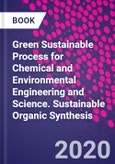Green Sustainable Process for Chemical and Environmental Engineering and Science: Sustainable Organic Synthesis provides an in-depth overview in the area of organic, pharmaceutical, engineering and environmental sciences, with a focus on the purification and extraction of fine chemicals, alternative green solvents, medicinal, analytical drugs, and bioactive compounds utilizing green chemistry protocols. It also focuses on the nanocatalysis, biocatalysis, solvent-free, recyclable organocatalysis, solid-supported reagents, heterogeneous polymer reusable catalysis, and CO2 conversion to commercial chemicals, utilizing industrial strategies such as flow-reactor, microwave, ultrasonics, ball-mill, photochemical and electrochemical methods.
Please Note: This is an On Demand product, delivery may take up to 11 working days after payment has been received.
Table of Contents
1. Introduction, parameters and advantages of greener organic synthesis2. Atom-economy green organic synthesis
3. Microwave-assisted organic synthesis
4. Ultrasound-assisted organic synthesis
5. Bioenzyme-assisted organic synthesis
6. Micellar-assisted organic synthesis
7. Solvent-free organic synthesis
8. Green organic synthesis by carbon oxide conversion
9. Ionic liquids-assisted organic synthesis
10. Green organic synthesis in supercritical water
11. Sustainable organic synthesis by electrochemical protocol
12. Green organic synthesis by flow approach
13. Recyclable organocatalysis in organic synthesis
14. Organic synthesis by photochemical protocol
15. Organic synthesis by eco-friendly solvents beyond water
16. Sustainable organic synthesis by water vs supercritical water
17. Nanocatalysis in Sustainable organic synthesis
18. Biocatalysis in organic synthesis
19. Recoverable polymer catalysis in organic synthesis
20. Solid-state sustainable organic synthesis
21. Employing sustainable pathways for organic synthesis
Authors
Rajender Boddula CAS Key Laboratory of Nanosystems and Hierarchical Fabrication, National Center for Nanoscience and Technology, China. Dr. Rajender Boddula is currently working as CAS-PIFI Fellow in the CAS Key Laboratory of Nanosystems and Hierarchical Fabrication, National Center for Nanoscience and Technology, Beijing, China. He has published many scientific articles in international peer-reviewed journals and has authored nine book chapters, and also serving as editorial board member and referee for reputed international peer-reviewed journals. His specialized areas of energy conversion and storage technologies, which include nanomaterials, graphene, polymer composites, heterogeneous catalysis, photoelectrocatalytic water splitting, biofuel cell, and supercapacitor applications Abdullah M. Asiri Chemistry Department, Center of Excellence for Advanced Materials Research, King Abdulaziz University,Jeddah, Saudi Arabia. Prof. Abdullah M. Asiri is the Head of the Chemistry Department at King Abdulaziz University since October 2009 and he is the founder and the Director of the Center of Excellence for Advanced Materials Research (CEAMR) since 2010 till date. He is the Professor of Organic Photochemistry. His research interest covers color chemistry, synthesis of novel photochromic and thermochromic systems, synthesis of novel coloring matters and dyeing of textiles, materials chemistry, nanochemistry and nanotechnology, polymers and plastics. A major achievement of Prof. Asiri is the discovery of tribochromic compounds, a class of compounds which change from slightly or colorless to deep colored when subjected to small pressure or when grind. This discovery was introduced to the scientific community as a new terminology published by IUPAC in 2000. This discovery was awarded a patent from European Patent office and from UK patent. He is also a member of the Editorial Board of various journals of international repute. He is the Vice- President of Saudi Chemical Society (Western Province Branch). He holds four USA patents, more than 800 Publications in international journals, seven book chapters, and ten books Inamuddin Assistant Professor, Department of Applied Chemistry, Zakir Husain College of Engineering and Technology, Faculty of Engineering and Technology, Aligarh Muslim University, Aligarh, India. Inamuddin is an assistant professor at the Department of Applied Chemistry, Zakir Husain College of Engineering and Technology, Faculty of Engineering and Technology, Aligarh Muslim University, Aligarh, India. He has extensive research experience in multidisciplinary fields of analytical chemistry, materials chemistry, electrochemistry, renewable energy, and environmental science. He has worked on different research projects funded by various government agencies and universities and is the recipient of awards, including the Fast-Track Young Scientist Award and the Young Researcher of the Year Award 2020 of the university. He has published about 189 research articles in various international scientific journals, 18 book chapters, and 144 edited books with multiple well-known publishers. His current research interests include ion exchange materials, a sensor for heavy metal ions, biofuel cells, supercapacitors, and bending actuators.








